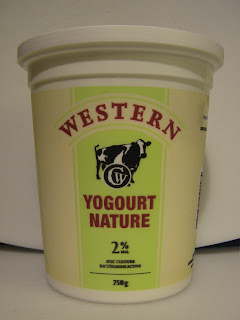I have discovered an easy method of making labneh, a Middle Eastern yoghurt cheese. This type of cheese is simply made by straining yoghurt.
Yoghurt is a dairy product that is readily available in supermarkets. It is produced by the bacterial fermentation of milk. Here is some great information about yoghurt:
- People who are lactose intolerant may be able to digest yoghurt, as most of the lactose (sugars found in milk) have already been broken down by bacteria
- Yoghurt helps in digestion
- All types of yoghurt contain beneficial bacteria
- Yoghurt can be used to marinate/tenderize meats (as in tandoori chicken)
- Beverages can be made from it (e.g. Indian lassi, smoothies, etc.)
- It is a great source of protein and calcium
When using yoghurt, in this recipe or in others, I would suggest purchasing ones that are made without the use of additives, i.e. gelatin, colours, sugars, artificial sweeteners, gums, etc. Simple and plain versions are usually found in the form of Balkan-style or Greek-style yoghurt and contain only milk (and/or cream) and bacterial culture. I have found that Western, a dairy company, makes a great product (as well as many other dairy products not containing additives).
Making Your Cream Cheese:
Begin with lining a colander or sieve with paper towel. You can also use cheesecloth, a coffee filter or a clean dishcloth for this process. Fill your lined container with yoghurt and put it in a place where the liquid can drain.
During this process, you are simply separating the curds (solids) from the whey (liquid). This liquid contains dissolved proteins. If you decide to keep the whey, produced in cheese-making, try to use it in these ways to boost the protein content in your meals:
- use it to soak beans
- add some to the water when boiling pasta
- pour some in a smoothie or shake instead of protein powder
- substitute for water in recipes for muffins, cakes and breads
If you have decided not to keep the whey, I would suggest that you let the yoghurt strain in/over a sink. You may also want to cover the yoghurt, so nothing gets into it.
After waiting approximately 4-7 hours, your cream cheese will be ready. Don't worry if you forget about it. You can keep it out for up to 24 hours.
Hint: I usually let my yoghurt strain overnight, so that I can have fresh cream cheese in the morning.
Suggestions for use:
- spread on a plate and top with olive oil and sea salt, for a savory dip
- use it to make tzatziki by whipping it with garlic and salt
- combined with fresh or dried fruit
- spread it on breads, bagels, croissants, etc.
- combine it with syrup or jam
- spread it on top of pancakes or omelettes
- drizzle some honey on top and have it as a sweet snack
Bonus: Your cream cheese will last upwards to a month in the refrigerator.
I am sure that you will find some great uses for this versatile cheese in your cuisine!
Hold on! You can make sour cream too!
Western also carries a product called Maslanka.
It is an Eastern European fermented yoghurt. I am not a fan of the Maslanka on its own. However, follow the same directions above, for straining yoghurt, and you will be left with an amazingly thick and flavourful sour cream. Yum!







I just updated this entry with a picture of Western's Maslanka. I hope it helps!
ReplyDelete